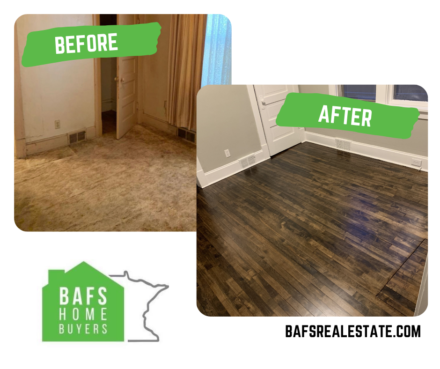 Hey hey, today we are talking about flooring. Oftentimes when looking at homes, if the flooring is good (i.e. well maintained, neutral colored, etc.) it can be an afterthought. This is because our eyes focus directly ahead rather than towards the ground. However, if your flooring is bad, whether it’s in rough shape or outdated, then it can easily become distracting and a deterrent for buyers. So we are here to discuss the five most common types of flooring we use when remodeling our homes and talk about where we use these types and why.
Hey hey, today we are talking about flooring. Oftentimes when looking at homes, if the flooring is good (i.e. well maintained, neutral colored, etc.) it can be an afterthought. This is because our eyes focus directly ahead rather than towards the ground. However, if your flooring is bad, whether it’s in rough shape or outdated, then it can easily become distracting and a deterrent for buyers. So we are here to discuss the five most common types of flooring we use when remodeling our homes and talk about where we use these types and why. HARDWOOD. Hardwood floors can be a thing of beauty when they are maintained and add value to your home. Plus, they are very durable when properly sealed and finished. They provide a traditional and timeless feel (or even rustic, if that’s what you’re going for), especially when used throughout the entire home. If we find hardwood floors underneath nasty carpet, it gets a facelift and stays. You can’t just get rid of it.
- Pros: Hardwood is durable when properly sealed and finished. It can provide a “classic” feel to your home but can also be refinished to keep in line with decorating trends. Also, depending on the type of wood used, floors are less prone to dents.
- Cons: If floors are pine or fir, they are more prone to dents. Hardwood can be more susceptible to water damage. Also traditional hardwood floors can more expensive than other flooring options.
CARPET. If you’re looking for a cozy spot to play with your kids or if you simply hate stepping out of bed onto a cold floor, choose carpet. We use carpet commonly in our homes’ upper levels because that is usually where the bedrooms are located as well as in family and living room areas.
- Pros: Carpet can cut down on noise, especially in second and third-levels. It is soft and warm underfoot. Also, all it requires is regular vacuuming and cleaning to maintain.
- Cons: Can become easily outdated (e.g. shag carpet) and an eyesore if not taken care of properly.
TILE. We use tile commonly in kitchens and bathrooms because it is water-resistant. It can also be used in entryways, mudrooms, and laundry rooms as well. It is very versatile and choosing specific patterns can be a great way to make a statement in your home.
- Pros: Water-resistant, versatile AND can improve your home’s resale value, need we say more?
- Cons: Tile, especially ceramic, can be a big (BIG) undertaking even in small spaces; statement tile floors can easily become outdated.
LUXURY VINYL PLANK [LVP]. Vinyl has gotten a facelift over the years to the point where it is unrecognizable – meaning what you may think is hardwood is actually LVP. So you get the look and feel of wood without the headache of maintaining it. Also, it is very durable and water resistant, so it can be used throughout your entire home.
- Pros: I’ll say it again: durable and water resistant. If you have kids, pets, crazy relatives, LVP may be a great addition to your home. It’s also easier to maintain than traditional hardwood or engineered floors.
- Cons: Hardwood and tile floors will improve your home’s resale value; LVP does not. (Bummer.) It can still scratch, although it does beat out hardwood and engineered flooring in that category. Also, it can difficult to install if your floors are uneven.
ENGINEERED. You might not be familiar with engineered flooring. Here’s the deal: engineered floors are multi-layer of material bonded together for stability with the top layer being real wood. Because of how its constructed you can use engineered floors throughout your home, even in bathrooms and kitchens.
- Pros: Engineered flooring is more cost effective than traditional hardwood. Also, construction allows it to hold up in areas with a lot of moisture. If you want to update your flooring you can because the top layer is real wood.
- Cons: While it is less expensive than traditional hardwood floors, it is still more expensive than other flooring options available. (I see you, LVP!) The surface is easily damaged/scratched. Plus, even though the top layer can possibly be refinished, depending on the thickness and quality of real wood on the top layer, you could possibly do more damage than good to your floors.
So there you have it. Of course, there is always more to explore and discuss, but we would rather know your thoughts. What kind of floors do you have in your home? What are your likes/dislikes? And what options would you choose if you were switching things up? Let us know. We love to hear from you!
